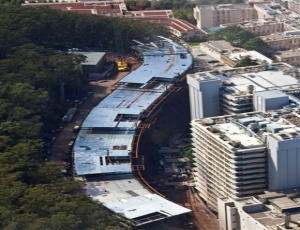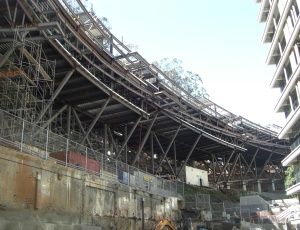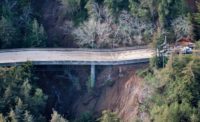Schuff Steel Pacific, a subsidiary of Schuff International Inc., reports that it has completed the majority of steel erection on the $123-million University of California San Francisco Institute for Regeneration Medicine located on the Parnassus Campus.


Schuff Steel Pacific, a subsidiary of Schuff International Inc., reports that it has completed the majority of steel erection on the $123-million University of California San Francisco Institute for Regeneration Medicine located on the Parnassus Campus.
Architect Rafael Vi�oly designed the institute, Smith Group is the design-build team architect and DPR Construction, Inc. is the general contractor on the project.
The institute is being constructed on a steep slope with an incline. The site is extremely narrow and is wedged between a winding road and adjacent buildings. The 46,283-sq-ft facility is a series of four elevated connected building pods that resemble inverted pyramids with terraced grass roofs. Each of the four building pods step up 9 ft higher than the next as the facility climbs up the slope at a slight angle. When complete, the multi-level structure will be 65 ft wide by 600 ft long.
�There is nothing typical about this building,� says Steve Carroll, project manager for Schuff Steel Pacific. The main entrance to the institute is 90 ft above ground level and accessed by a free standing elevator outside of the facility. The building can also be accessed by a 130-ft long by 90-ft high steel pedestrian bridge currently under construction that connects the institute to the ninth floor of the adjacent Health Science Building. The structure is supported by HSS steel braces, beams and 20 steel columns that bear on concrete piers.
To ensure maximum earthquake protection, Forell/Elsesser Engineers, Inc., the structural engineers on the project, fitted the institute with 42 Friction Pendulum seismic isolators that are located between the foundation and the structure at every anchor of the building. Seismic isolators dramatically reduce impact from seismic ground motion. They dissipate earthquake energy and significantly reduce seismic distortions that would otherwise force the building out of its original shape. Friction Pendulum bearings will allow the structure to slide 26 in. in any horizontal direction, and 2 in. vertically to �filter� the earthquake�s movement and give the building a relatively gentle ride.
In addition to seismic isolators, Forell/Elsesser designed and collaborated with Schuff to fabricate and install a first-of-its-kind independent uplift restraint. Forell/Elsesser developed the uplift restraint to keep the building from lifting during an earthquake. The uplift restraints are positioned on the south side of the building where they will oppose the 20-ft cantilevers on the north side, which have no ground support. In the event of an earthquake once the building starts to lift, the uplift restraints will engage and hold the building down with up to 100 tons of uplift force. A prototype was tested at the University of California San Diego�s Caltrans Seismic Response Modification Devices test facility.
Schuff says it fabricated the eight uplift restraints within 1/1000th of an in. tolerance at its Gilbert, Arizona steel plant. Each uplift restraint is 6 ft square by 3 ft tall.
According to Mason Walters, S.E., principal at Forell/Elsesser Engineers, �We examined a number of different options to make this facility as earthquake resistant as possible. We developed the uplift restraint to augment the seismic isolators where the building juts out. During an earthquake, the uplift restraints are designed to move in the same direction as the Friction Pendulum seismic isolators until the building starts to lift at which point the uplift restraints act to hold the structure down, while continuing to allow free horizontal movement.�
To augment Forell/Elsesser�s technical drawings and further demonstrate how the uplift restraint would work, Walters actually built a model of the device in his garage.
Working closely with the university, DPR Construction, Forell/Elsesser and Schuff worked in a design-assist capacity to fabricate and plan steel erection.
According to Steve Marusich, an associate at Forell/Elsesser Engineers, �Design-build was the only way to cost effectively engineer, fabricate and erect this complex facility. It allowed the entire design and construction team the ability to arrive at creative solutions to construct the facility within budget while meeting the rigorous demands of the design and site location.� The Institute for Regeneration Medicine is scheduled for completion in mid-2010.


Post a comment to this article
Report Abusive Comment